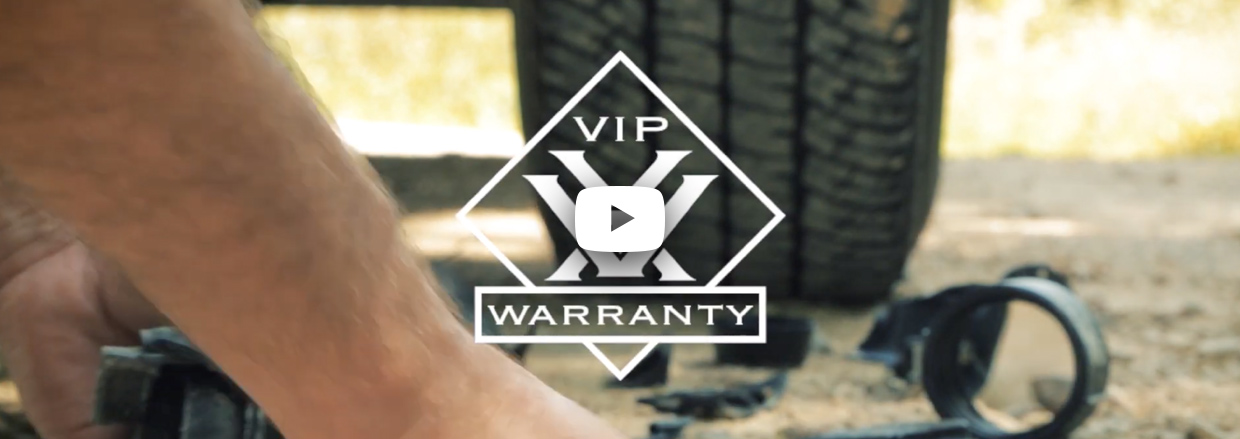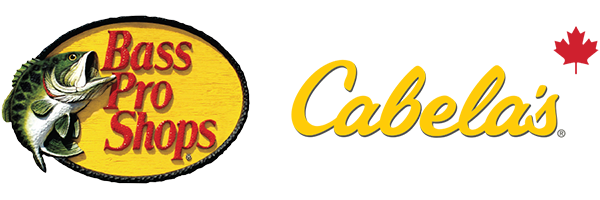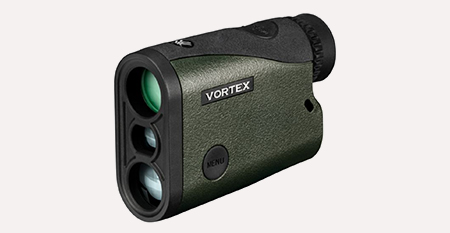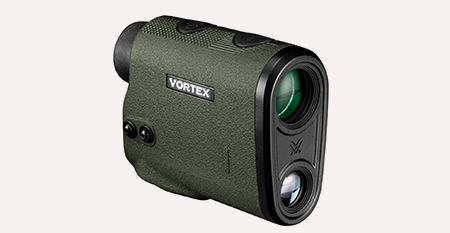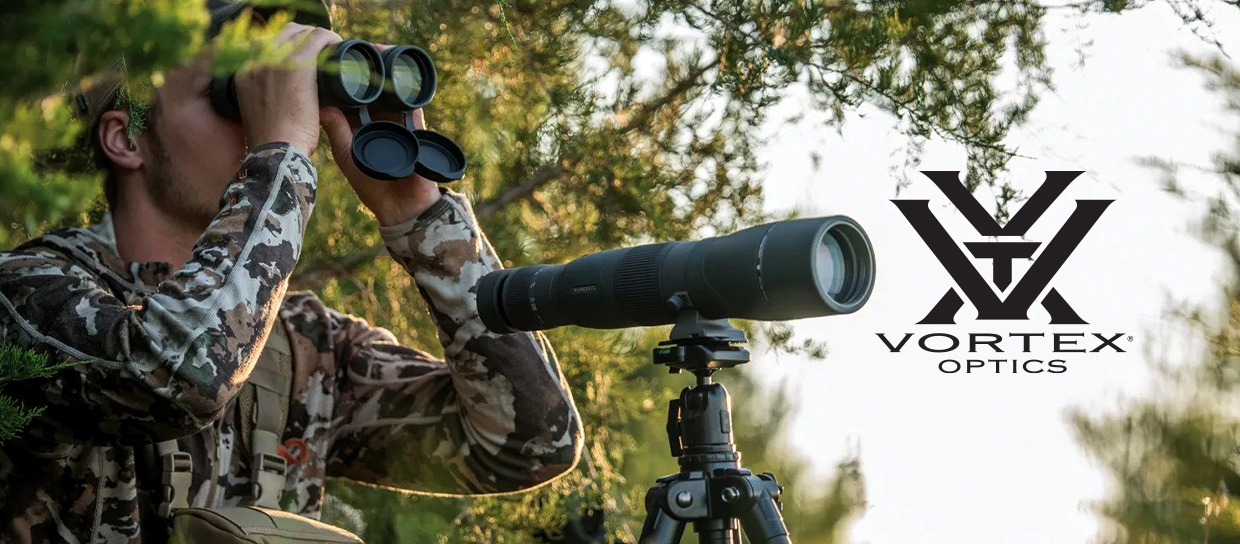
HUNTS AS HARD AS YOU DO
The hunt is never just a hunt — it’s a journey that starts well before you make your way to the field. It begins with the right gear. And Vortex has the optics to send you on your way to a triumph in the wilderness. Whether you need a riflescope for a clear shot of the buck beyond the trees, or binos with a wide view of the hunting landscape, Vortex is committed to helping you see things clearly.
Go Further. See Farther.
RANGEFINDERS
Scope out targets from farther distances with greater accuracy with powerful, fully-loaded rangefinders from Vortex.
Rangefinders Comparison Chart

BINOCULARS
With strong magnifications and large fields of view, Vortex binoculars provide a clear, crisp image, even in low-light environments.
Binoculars Comparison Chart

KNOW THE NUMBERS

What do the numbers mean?
First number: Refers to the magnification provided by the binocular. As magnification increases, image detail also increased, but field of view decreases and it becomes more difficult to steadily handhold the binoculars.
Second number: Refers to the diameter of the objective lens. As the objective size increases the binocular allows in more light providing brighter images. At the same time, the binocular increase in size and weight.
What configuration is best for me?
| 8x42 | 10x42 | 10x50 / 12x50 | 15x56 / 18x56 |
|---|---|---|---|
| An 8x42 binocular is a lightweight configuration, ideal for scanning areas that have wide expanses, scenes with a lot of movement, or are densely wooded. | A 10x42 is a do-it-all binocular configuration with the lightweight benefits of the 8x42, but with more powerful magnification. | The 10x50 or 12x50 is often used for scanning longer distances. With a wider field of view than a spotting scope, it bridges the gap between high-magnification models that require a tripod and handheld options for backcountry. | The 15x56 and the 18x56 reduce pack weight and bulk by eliminating the need of a spotting scope from your kit. Pick apart distant landscapes with these tripod-mounted configurations. |
Western Hunting
Rugged mountain country and vast, open landscapes define the West. Quality optics are essential for methodically dissecting game-hiding terrain at extreme distances. Your buck or bull is out there — the right optics will help you find them
Magnification: Big country, bigger glass — it’s important for your eyes to do the walking. More magnification will help you find, identify, and evaluate big game at distance. As magnification increases, steadiness decreases. Use a tripod when glassing with higher-powered binoculars for rock-steady viewing.
Objective Size: All else equal (model/magnification), a larger objective increases the size of the binocular’s exit pupil. A larger exit pupil allows more light to hit your eye, and increases the binocular’s ability to perform in low-light scenarios. A larger objective results in an overall bigger binocular, adding weight and bulk. All things to consider when making your selection.
Optics: Optical quality is critical to pick apart the landscape efficiently, and when you’re spending hours behind glass comma, reduces eye fatigue. Choose the best optical system you can afford for superior image resolution, clarity, and colour accuracy.
Our Binocular Recommendation:
GOOD: Vortex® Crossfire® HD 10x42 Binoculars w/ GlassPak™
BETTER: Vortex® Diamondback® 10x42 Binoculars w/Glasspak™
BEST: Vortex® Viper HD 10x42 Binoculars w/Glasspak™
Note – When using a binocular over 12x it is highly-recommended using a tripod for stabilization.
Midwestern & Eastern Hunting
Turkeys to whitetails, cropland to dark timber, Midwestern and Eastern hunters know the importance of the right optic.
Magnification: Less is more when it comes to magnification. Reduced magnification provides a wider field of view and better light transmission. Translation — you’ll get it on target quicker and glass more effectively early and late in the day.
Objective Size: Comparing two binoculars of equal objective diameter, the binocular of lower magnification produces a larger exit pupil. This means more light to hit your eye, which aids in low-light performance and maximizes your hunting an observation hours.
Optics: Most animals are on the move at dawn and dusk. Having optics that excel in low-light situations will give you the clarity and detail you need when daylight fades.
Our Binocular Recommendation:
GOOD: Vortex® Raptor® 10x3 Binoculars
BETTER: Vortex® Diamondback® 8x42 Binoculars w/Glasspak™
BEST: Vortex® Viper HD 10x42 Binoculars w/Glasspak™
Glassing
Nature doesn’t stand still. Whether you’re a casual wildlife observer or dedicated birder, optical quality is a critical factor to get the most of your time outdoors.
Magnification: Generally speaking, wildlife observation doesn’t require high-powered magnification. An optic with wider field of view will allow for quick target identification to ensure you don’t miss anything.
Objective Size: Big glass is hard to hold steady. Size down to binocular with a smaller objective lens to cut weight for easier handling.
Optics: Never misidentify a critter again! Besides realistic colour representation, an optic with superior colour fidelity is essential for identifying targets as accurately as possible.
Our Binocular Recommendation:
GOOD: Crossfire HD 8x42
BETTER: Diamondback HD 8x42
BEST: Viper HD 8x42
Precision
Shooters are stretching their effective range farther than ever. The right binocular helps identify corrections and helps squeeze the most performance out of your longe-range rig.
Magnification: High-powered magnification makes it easier to spot impacts and make correction. Get on target faster with plenty of optical horsepower for the job.
Objective Size: Magnification trumps weight in the long-range game. Higher magnification increases clarity at distance for superior target detail.
Optics: Impacts on steel targets aren’t easy to identify. All else equal, a superior optical system provides better resolution for accurately spotting impacts or calling adjustments at a distance.
Our Binocular Recommendation:
GOOD: Vortex® Diamondback® 12x50 Binoculars w/Glasspak™
BETTER: Vortex® Viper HD 12x50 Binoculars w/Glasspak™
BEST: Vortex® Fury HD 5000 10x42 Rangefinding Binocularsk™
Note – When using a binocular over 12x it is highly-recommended using a tripod for stabilization.
SCOPES
These high-powered optics make for easier glassing and quicker target acquisition. With varying ranges, magnifications, and weights, there’s a Vortex scope that suits the way you shoot.
Riflescope Comparison Chart

How to choose your riflescope
Choose Your Application
Western Hunting
Majestic mountain tops, wide open plains, and severe weather challenge Western hunters to not just place long-range shots, but to place them consistently under stress.
Magnification & Configuration:With more open spaces comes more need for a high-power optic, but that doesn’t mean you have to give up a solid field of view. Popular magnification ranges would include 3-15x, 4-16x, and 6-24x.
Turrets: A western hunter is more likely to encounter long-range shots and may want a more feature-rich turret. Exposed elevation turrets allow rapid adjustment, and a locking turret means you can keep those adjustments in place. Zero stops give you a reliable return to your original zero after dialing.
Reticle: To enable accurate shot placement at longer distances, Western hunters can benefit from more robust reticle systems. Common reticle tools allow hunters to effectively determine ranges, holdovers, windage corrections, and moving target leads. Illimuniated reticles ensure a clear point of aim in low light, when big game is often on the move. Finally, utilizing a First Focal Plane reticle for longer range hunting means that the reticle subtensions are accurate throughout the magnification range.
Our Scope Recommendation:
GOOD: Vortex® Diamondback HP4-16x42 Riflescope
BETTER: Vortex® Viper HS LR 4-16x44 Riflescope
BEST: Vortex® Viper PST Gen II 5-25x50 FFP Riflescope
Note – When using a binocular over 12x it is highly-recommended using a tripod for stabilization.
Midwestern & Eastern Hunting
From thick forests to mountains, heavy snow to driving rain, Midwestern and Eastern hunters see it all, and need a riflescope that can cover near and far shots while standing up to the elements.
Magnification: Midwestern and Eastern hunting riflescopes will be lower in magnification, taking advantage of a wider field of view and usually better low-light performance than higher magnification models. Popular magnification ranges include 2.5-10x, 3-9x, 4-12x, or 4-16x.
Turrets: Midwestern and Eastern hunters prefer capped turrets to keep adjustments protected from bumps or snags in the field.
Reticle: Reticles designed for Midwestern and Eastern hunting are carefully designed to be as simple as possible. The classic Second Focal Plane (MOA) duplex crosshair reticle is still perfectly relevant, and BDC reticles take that same idea, but add in a few hashmarks for easy holdovers at farther distances with modern calibres.
Our Scope Recommendation:
GOOD: Crossfire II 3-9x40, 4-12x40
BETTER: Diamondback 3-9x40, 4-12x40
BEST: Viper HS 2.5-10x44
Precision
To extend your range and accuracy, you’ll need an optics that blends precision and a rugged build.
Magnification: A magnification range appropriate for small targets at both medium and long-range is necessary. Being able to rapidly acquire targets is important when time is of the essence, and a large field of view aids the shooter in locating targets quickly and efficiently. Having an optic with a wide range of magnification and large field of view are both features paramount to success.
Turrets: With all the bumps and movements associated with an intense course of fire, locking turrets can help ensure you don’t dial by accident. Zero stops ensure you don’t lose track of where you are within the overall travel range of your turret’s system.
Reticle: A First Focal Plane reticle will give you an advantage allowing you to utilize your reticle subtensions and visual features accurately throughout the magnification range. “Christmas tree” style reticles allow the user to hold for both elevation and wind corrections simultaneously and precisely. Other tools allow you to quickly estimate range, measure targets, calculate corrections, and even make shots on moving targets
Our Scope Recommendation:
GOOD: Venom 5-25x56 FFP
BETTER: Viper PST Gen II 3-15x44, 5-25x50 FFP, Strike Eagle 5-25x56 FFP
BEST: Razor HD Gen III 6-36x56 FFP
RED DOTS
Lightning-quick, long-lasting Vortex red dots are your best option for crystal-clear targeting at close range.
Vortex® Warranty
No questions asked – it’s covered.
Unlimited. Unconditional. Lifetime warranty.
In the event your Vortex® product is defective or becomes damaged, Vortex will repair or replace it with no cost to you. It does not matter how it happened or whose fault it was. The VIP (Very Important Promise) warranty is fully transferable, no receipt needed.
For more information on Vortex’s VIP warranty, or to start a claim, head to Vortex Canada’s website here.
